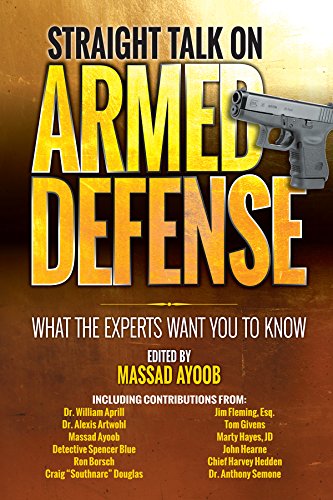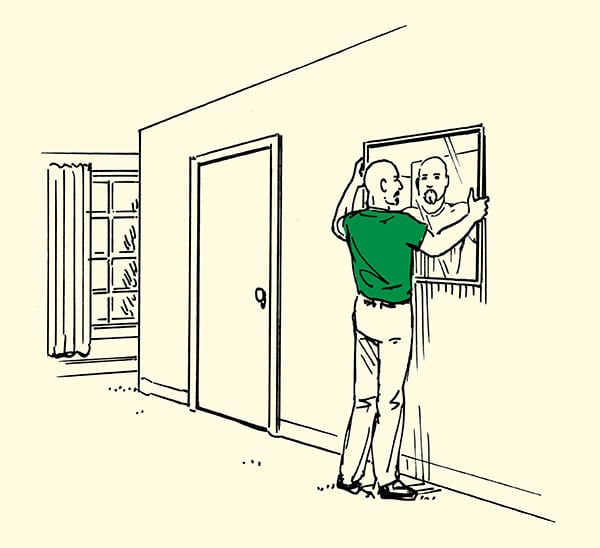It’s 2 AM, and you’re lying asleep in bed. Your wife is snuggled next to you, and your young children are slumbering soundly in their respective bedrooms.
The sound of the creaking back door awakens you. You weren’t expecting any late-night visitors.
It could be an intruder . . . or not. Maybe you forgot to shut the back door all the way and lock it, and the wind’s blown it open. (Sheepdog Rule #24: Always check to see if the doors are locked before you retire for the night.)
How do you investigate this possible home intrusion quickly and safely? How do you navigate through your house in a way that maximizes your safety when there could be a possible attacker on the prowl?
Today we’re going to walk you through how to effectively clear your home. In the tactical world, “clearing a building” simply means investigating the premises for a suspected intruder. A building is “cleared” if you confirm the suspect isn’t there or you neutralize the threat.
To get the inside scoop on how execute this tactical skill, I talked to my buddy Mike Seeklander from the American Warrior Society and Shooting Performance.
First Rule of Clearing a House: Only Clear Your House By Yourself as a Last Resort
 The Practical Guide to...
Best Price: $13.71
Buy New $12.82
(as of 11:32 UTC - Details)
The Practical Guide to...
Best Price: $13.71
Buy New $12.82
(as of 11:32 UTC - Details)
In law enforcement and the military, clearing a building is done in teams of two or more because it’s safer and more effective. That extra set of eyes allows you to have a 360-degree view.
If you’re clearing your home, it’s probably just you. Because you don’t have eyes in the back of your head, your field of vision is limited, leaving you vulnerable to attacks in your blind spots.
With that in mind, Mike recommends that you only clear your own house by yourself as a very last resort.
For example, if you arrive home and notice that a window is smashed or a door is open, and you suspect an intruder is still inside, don’t go in and clear your home alone. Stay outside at a safe distance and call the police to report a possible ongoing breaking and entering. Let the professionals take care of it.
If you live by yourself and an intruder breaches your place while you’re at home asleep, stay in your room, lock the door, call 911, and ready your weapon. Stay in there until law enforcement officers arrive. Once they do, make sure whatever weapon you’re using is holstered or put away, so they don’t mistake you for the bad guy.
The only situation in which you’d want to clear a home by yourself is if you have loved ones in another part of the house, and you’re worried about their safety. Even then, you must proceed with extreme caution.
Bottom line: clearing your home by yourself is a dangerous task. Only do it if you absolutely must!
Set Up Your Home for Successful Clearing
Clearing a building is dangerous because you can’t see through doors and walls or around corners. Consequently, several tactics must be used to allow you to navigate a house while reducing (but not eliminating) your chances of being blindsided by an attack. We’ll discuss those here in a bit.
To further reduce the risks of clearing your home, Mike recommends using technology and smart interior design to increase your field of vision without putting yourself in harm’s way.
First, install security cameras throughout your home. This will allow you to see where the possible threat is without having to expose yourself physically. Nest Cam and Ringmake affordable wireless cameras that connect to your smartphone.
 Straight Talk on Armed...
Best Price: $13.11
Buy New $14.95
(as of 10:10 UTC - Details)
Straight Talk on Armed...
Best Price: $13.11
Buy New $14.95
(as of 10:10 UTC - Details)
After you’ve installed these cameras, think about how you can decorate your home so that your ability to see around corners is enhanced. Place mirrors and reflective framed pictures in strategic locations so that you can see into a hallway or another room from a distant and concealed location. Motion activated lights are also an excellent addition to place the advantage in your court.
Preparing Your Firearm
Even though the rifle is a generally superior weapon, Mike recommends that most individuals use a pistol for clearing a house as it’s easier to maneuver with than a rifle or shotgun. With that said, if all you have is a rifle or a shotgun, use it. A firearm puts some much-needed distance between you and the possible threat.
Whichever type of firearm you go with, Mike strongly recommends having a light/laser sight mounted on it like a Streamlight TLR-2 with grip activation switch. This makes illuminating and aiming in low-light situations much easier.
Home Clearing Tactics
Choose Your Pace: Slow or Hasty
When you’re searching a building, there are two paces you can take: hasty or slow. Which speed you use depends on the situation.
If your loved ones aren’t in immediate danger, take things slow. It’s safer for you and allows you to be more deliberate when searching your home for intruders.
If you believe your loved ones are in immediate danger, do a hasty search. Even as you speed up the pace, however, you still want to practice good clearing tactics to keep yourself safe.
How to Hold Your Pistol When Clearing Your Home
If you’re clearing your house with a pistol, hold your firearm in a high ready position. This position allows you to maneuver throughout your home quickly and with a reduced profile while simultaneously staying ready to fire when needed.
Constantly Check Your Six
 The Law of Self Defens...
Best Price: $20.54
Buy New $22.48
(as of 08:30 UTC - Details)
The Law of Self Defens...
Best Price: $20.54
Buy New $22.48
(as of 08:30 UTC - Details)
As you’re clearing your home, it can be easy to get “target lock.” You become so focused on clearing a corner or a doorway that you become unaware of what’s going on behind or to the side of you. As you clear different obstacles in your home, keep your head on a swivel. Don’t become so focused on one area that you become blind to everything else.
The Master Tactic of Clearing Your Home: Slicing the Pie
When you’re clearing a building, you have two contradictory goals: 1) find and eliminate the threat, and 2) keep yourself concealed from the threat. If you go bulldozing towards an intruder, you leave yourself open to attack. If you completely conceal yourself from your potential attacker, however, it becomes hard for you to spot and possibly neutralize him because doors, corners, and objects are in your way.
To navigate between this strategic Scylla and Charybdis, we’re going to use a building-clearing tactic called “slicing the pie.” Slicing the pie is also known as “threshold evaluation” or “angled clearing.”
Slicing the pie allows us to slowly increase our field of vision around corners, through doorways, and up and down stairs, all while keeping a reduced profile. When you slice the pie, you use an angle to keep yourself concealed and slowly step away from the apex of that angle to gradually reveal a new “slice” of the room. When a new slice of the room is revealed, quickly scan it from top to bottom for your threat or evidence of your threat. Once you’ve noted that it’s clear, reveal another small slice of the room and scan again.
While the general concept of slicing the pie applies to corners, doorways, and stairways alike, the details of how to approach each area differ slightly, as we’ll cover below.







